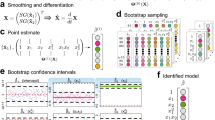Abstract
Recently some methods have been presented to extract ordinary differential equations (ODE) directly from an experimental time series. Here, we introduce a new method to find an ODE which models both the short time and the long time dynamics. The experimental data are represented in a state space and the corresponding flow vectors are approximated by polynomials of the state vector components. We apply these methods both to simulated data and experimental data from human limb movements, which like many other biological systems can exhibit limit cycle dynamics. In systems with only one oscillator there is excellent agreement between the limit cycling displayed by the experimental system and the reconstructed model, even if the data are very noisy. Furthermore, we study systems of two coupled limit cycle oscillators. There, a reconstruction was only successful for data with a sufficiently long transient trajectory and relatively low noise level.
Similar content being viewed by others
References
Cohen AH, Holmes PJ, Rand RH (1982) The nature of the coupling between segmental oscillators of the lamprey spinal generator for locomotion: a mathematical model. J Math Biol 13:345–369
Cremers J, Hübler A (1987) Construction of differential equations from experimental data. Z Naturforsch 42a:797–802
Crutchfield JP, McNamara BS (1987) Equations of motion from a data series. Complex Syst 1:417–452
Eckmann JP, Ruelle D (1985) Ergodic theory of chaos and strange attractors. Rev Mod Phys 57:617–656
Farmer JD, Ott E, Yorke JA (1983) The dimension of chaotic attractors. Physica 7D:153–170
Farmer JD, Sidorowich JJ (1987) Predicting chaotic time series. Phys Rev Lett 59:845–848
Farmer JD, Sidorowich JJ (1988) Predicting chaotic time series. In:Kelso JAS, Mandell AJ, Shlesinger MF (eds) Dynamic patterns in complex systems. World Scientific Publishing, Singapore, pp 265–292
Glass L, Mackay MC (1988) From clocks to chaos. Princeton University Press, Princeton NJ
Grassberger P, Procaccia I (1983) Characterization of strange attractors. Phys Rev Lett 50:346–349
Haken H (1977) Synergetics, an introduction. Springer, Berlin Heidelberg New York
Haken H, Kelso JAS, Bunz H (1985) A theoretical model of phase transitions in human hand movements. Biol Cybern 51:347–356
Hoppenstadt FC (1986) An introduction to neurons. Cambridge University Press, Cambridge
Kay BA, Kelso JAS, Saltzman EL, Schöner G (1987) Space-time behavior of single and bimanual rhytmical movements: Data and limit cycle model. J Exp Pyschol 13:178–192
Kay BA, Saltzman EL, Kelso JAS (1991) Steady state and perturbed rhythmical movements: dynamical models using a variety of tools. J Exp Psychol Hum Percep Perf (in press)
Kelso JAS (1984) Phase transitions and critical behavior in human bimanual coordination. Am J Physiol: Reg Integ Comp 15:R1000-R1004
Kelso JAS, Schöner G (1987) Toward a physical (synergetic) theory of biological coordination. Springer Proceedings in Physics, vol. 19. Springer, Berlin Heidelberg New York, pp 224–237
Kelso JAS, Schöner G (1988) Self-organization of coordinative movement patterns. Hum Mov Sci 7:27–46
Kelso JAS, Scholz JP (1985) Cooperative phenomena in biological motion. In: Haken H (ed) Complex systems: operational approaches in neurobiology, physics and computers. Springer, Berlin Heidelberg New York, pp 124–149
Kelso JAS, Holt KG, Rubin P, Kugler PN (1981) Patterns of human interlimb coordination emerge from nonlinear limit cycle oscillatory processes: theory and data. J Motor Behav 13:226–261
Packard NH, Crutchfield JP, Farmer JD, Shaw RS (1980) Geometry from a time series. Phys Rev Lett 45:712–716
Pandit SM, Wu SM (1983) Time series and system analysis with applications. Wiley, New York
Rose M, Kautzky T, Deisz P, Hübler A, Lüscher E (1989) Resonant stimulation and control of Karman's vortex street. Helv Phys Acta 62:286–289
Schöner G, Kelso JAS (1988a) Dynamical pattern generation in behavioral and neural systems. Science 239:1513–1520
Schöner G, Kelso JAS (1988b) A synergetic theory of environmentally-specified and learned patterns of movement coordination. I. Relative phase dynamics. Biol Cybern 58:71–80; II. Component oscillator dynamics. Biol Cybern 58:81–90
Takens F (1981) Detecting strange attractors in turbulence. In: Rand DA, Young LS (eds) Dynamical systems and turbulence. Springer, New York Berlin Heidelberg, pp 366–381
Winfree AT (1987) Biological clocks. Freeman, San Francisco
Author information
Authors and Affiliations
Rights and permissions
About this article
Cite this article
Eisenhammer, T., Hübler, A., Packard, N. et al. Modeling experimental time series with ordinary differential equations. Biol. Cybern. 65, 107–112 (1991). https://doi.org/10.1007/BF00202385
Received:
Accepted:
Issue Date:
DOI: https://doi.org/10.1007/BF00202385




